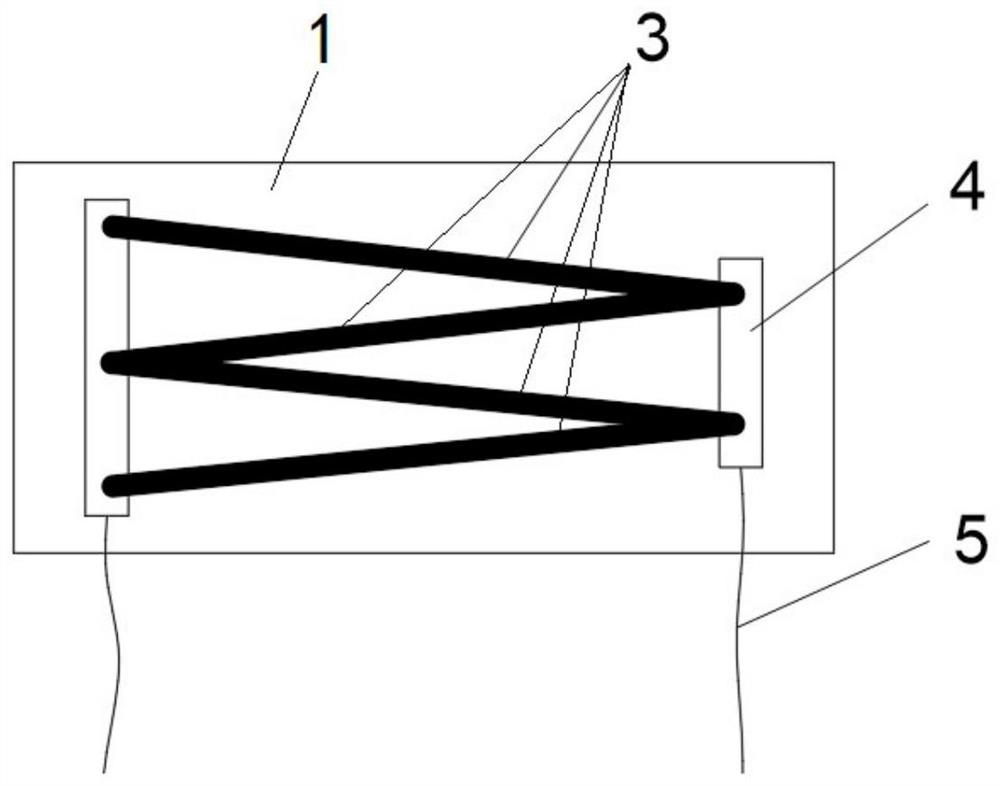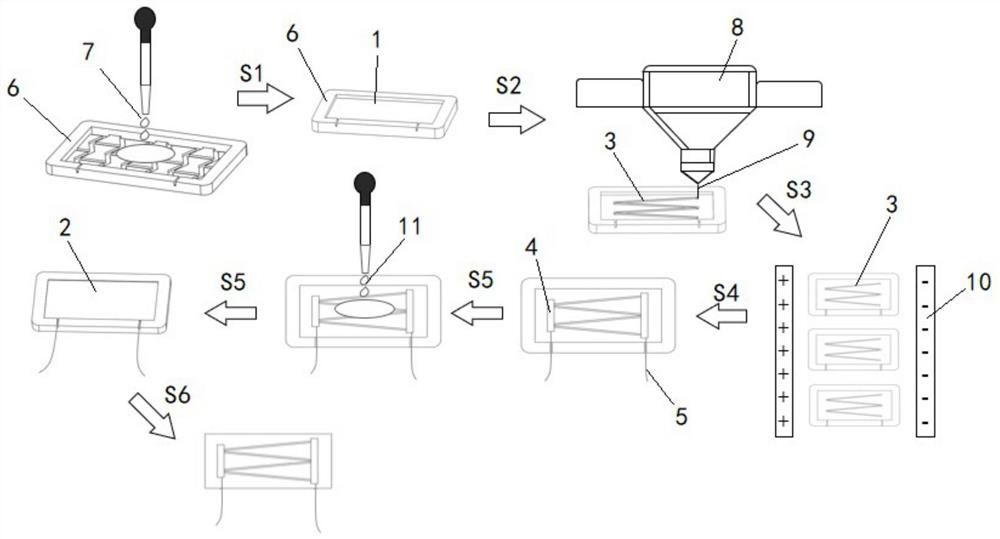A kind of parallel flexible strain sensor and preparation method thereof
A strain sensor, parallel technology, applied in the direction of electric/magnetic solid deformation measurement, electromagnetic measurement device, etc., can solve the problems of low conductivity of conductive polymer lines, low strain rate of conductive polymer lines, unable to achieve a predetermined sensitivity, etc., to achieve improvement Uneven deformation, wide application range, fast and diverse effects
- Summary
- Abstract
- Description
- Claims
- Application Information
AI Technical Summary
Problems solved by technology
Method used
Image
Examples
Embodiment 1
[0036] see figure 1 and figure 2 , the parallel flexible strain sensor in the figure is a specific embodiment of the present invention, which specifically includes a structural layer 1, an encapsulation layer 2, a conductive polymer circuit 3, a conductive glue 4 and a wire 5, wherein the structural layer 1 is the sensor body structure , which produces strain under the action of the load, the conductive polymer circuit 3 is packaged and arranged on the structural layer 1, and is connected to the detection circuit through the wire 5. The strain generated by the structural layer 1 drives the conductive polymer circuit 3. The lengthening or shortening changes, resulting in The resistance strain changes the current of the detection circuit connected to the sensor, so as to achieve the purpose of strain detection.
[0037] like figure 1 As shown in the figure, the structural layer 1 of this embodiment is provided with convex auxetic structures distributed in an array on the surf...
Embodiment 2
[0042] like image 3 As shown, the preparation method of the parallel flexible strain sensor in this embodiment specifically includes the following steps:
[0043] S1: According to the mass ratio of curing agent B agent: polydimethylsiloxane agent A = 1:10, configure the first flexible base liquid, curing agent B agent is polydimethylsiloxane agent A, which is used together Commonly used curing agent. A layer of the first flexible base liquid 7 is evenly coated in the groove of the mold 6, and then placed in a 100°C incubator for curing for 40 minutes to form the structural layer 1. Auxetic structures are directly formed.
[0044] S2: Put carbon nanomaterials, isopropanol and polydimethylsiloxane A into a beaker and mix them. The role of isopropanol here is a diluent. In order to better disperse carbon nanomaterials, ultrasonically disperse the mixture for 30 minutes. , magnetic stirring for 2 hours in a water bath at 90 °C, then adding the curing agent B, and stirring to o...
Embodiment 3
[0051] The preparation method in Example 2 was repeated, but in step S2, the carbon nanomaterials in the prepared carbon nanomaterial mixture accounted for 3wt%; in step S3, the mold was placed in a 2000V / cm high-voltage direct current electric field and allowed to stand for 20min.
[0052] The sensitivity test of the flexible strain sensor prepared in this example shows that the sensitivity index of the strain sensor is GF=58.4 (10% Figure 5 The mid-dotted line is shown. Because under the induction of the electric field, the carbon nanomaterials in the conductive polymer circuit are arranged in an orderly manner along the direction of the electric field, so only a small amount of carbon nanomaterials can achieve an orderly conductive path, thereby greatly improving the sensitivity of the sensor. Compared with the non-discharge field strain sensor, it can be seen that the sensitivity is increased by a factor of 16.
PUM
| Property | Measurement | Unit |
|---|---|---|
| strength | aaaaa | aaaaa |
Abstract
Description
Claims
Application Information
 Login to View More
Login to View More - R&D
- Intellectual Property
- Life Sciences
- Materials
- Tech Scout
- Unparalleled Data Quality
- Higher Quality Content
- 60% Fewer Hallucinations
Browse by: Latest US Patents, China's latest patents, Technical Efficacy Thesaurus, Application Domain, Technology Topic, Popular Technical Reports.
© 2025 PatSnap. All rights reserved.Legal|Privacy policy|Modern Slavery Act Transparency Statement|Sitemap|About US| Contact US: help@patsnap.com



